The Grand Wilcockson Tour to Derbyshire Day 3: Shepshed, Rev. Adam Blakeman, Great Bowden and Richard III
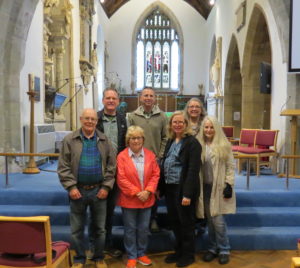
Copyright © Jane E. Wilcox, Forget-Me-Not Ancestry, Albany, NY www.4getmenotancestry.com.
In September 2017 I led a tour to Derbyshire, England, in search of my Puritan ancestors William Wilcockson and his wife Margaret. They came to New England on the Planter in 1635 with their two-year-old son John Wilcockson and Ann Harvie, whom I believe to be Margaret’s sister. They came during the Puritan Great Migration 1620-1640. With them on the Planter were Margaret’s first cousins Richard Harvie and his sister Mary Harvie with her husband William Beardsley and their three children Mary, John and infant Joseph. This homecoming trip with my cousins in 2017 culminated my research on the Wilcocksons of Biggin-by-Hulland, the Harvies of Ilkeston and their minister Rev. Adam Blakeman/Blackman (who founded Stratford, Conn. with them in 1639) that I undertook on three genealogy research trips to England between 2000 and 2015.
On this trip my cousins and I followed in the footsteps of Puritan William and Margaret Wilcockson (not spelled Wilcoxson as many have tried to modernize it) from their origins in Derbyshire, England, to their exposure to non-conformist ideas that eventually caused them to emigrate to America, to the churches they attended, to their dissenting Puritan network of family and friends, to their journey to the port of London to take passage on the Planter in 1635. While in England I sent daily emails to about 50 of my extended family and friends, as I had done in the past with the three other research trips, sharing our journey with them. The emails sent during the trip have been expanded and fact-checked to present here as blog posts. When you are reading my account of Puritan William in England, keep in mind that this is a proposed family of origin for William Wilcockson of Stratford, Conn. based on the evidence in the available records. Think “probable” and “probably” when you read Puritan William’s story.
Down the road I will write a series of articles giving the documentary evidence as to why I believe Puritan William was the son of tanner William Wilcockson and his first unknown wife from Biggin-by-Hulland, Derbyshire, and why Puritan William’s wife Margaret was Margaret Harvie, daughter of weaver James Harvie and his wife Elizabeth Winfield from Ilkeston Derbyshire — and not Margaret Birdseye or Birdsey as has long been erroneously held. These articles will contain more details and all of the sources I used to compile the evidence, as well as the genealogies of the Wilcockson, the Harvie and the Blakeman families in England in the 1500s and early 1600s.
Day 3
Today was the Puritan Divine day. Divines are what the Puritan ministers were called.
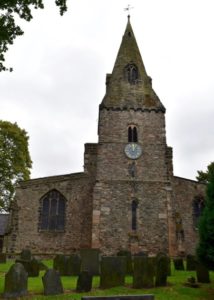
St Botolph’s church, Shepshed. Photo by Robb Wilcox.
The first stop was St Botolph’s church in Shepshed, Leicestershire, about 30 miles southeast of Biggin. We met the current vicar, Rev. Lydia, who spent an hour answering question after question after question that Deborah and I threw at her. We talked about the current Church of England and about the Church of England during the reform period (our Puritan period), and comparing then to now. Rev. Lydia was one of the first women to be ordained in the Church of England 25 years ago. She’s been vicar here for three months.
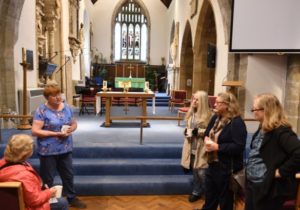
Rev. Lydia answering questions. Photo by Robb Wilcox.
Our conversation focused on the types of minsters in the Church of England then and now: with a rector or vicar as incumbents (the ones who were the heads of the parish churches), curates who were working their way up the church ladder and were supervised by a rector or vicar, and deacons who were the lowest in the ordination ranks. In the days of the reformers in the 1600s they also had the lecturers. I’ll explain more about lecturers on our second Puritan Divine stop below.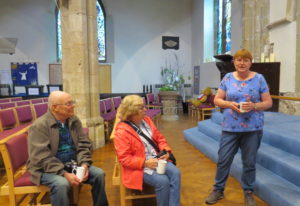
Picking up the Wilcockson story in Shepshed: My ancestor Puritan William Wilcockson’s mother died, possibly in childbirth, and his father, tanner William Wilcockson, married much younger Winifred Ollerenshaw as his second wife. Winifred was the daughter of the vicar at Shepshed, Rev. Peter Ollerenshaw. Somehow tanner William from Biggin met the Ollerenshaws in Shepshed — 30 miles apart. It could have been through William’s tanning business — taking his hides to one of the market towns where the Ollerenshaws and people from Shepshed frequented, or possibly through the Puritan network in the Midlands. It could have been through tanner William’s relative Bryan Wilcockson who moved from Biggin to Loughborough (only 5 miles from Shepshed) by 1560 when his son John was baptized at Loughborough.
The Puritan network in the Midlands was quite extensive. The rector of All Saints Church at Loughborough starting in 1562 for Bryan Wilcockson and his family was radical reformer John Williock from Scotland. Williock baptized at least three of Bryan and Anne’s children at Loughborough in the 1560s and 1570s. Previously Williock had been a close associate of John Knox, the “founder” of Presbyterianism in Scotland. Williock had to flee England when Catholic Queen Mary ruled England and persecuted Protestants in the 1550s — think burning Protestant heretics at the stake. That’s why she’s called Bloody Mary.
Going back a few decades prior to Mary, you may remember that King Henry VIII broke off from the Catholic church in the 1530s and established the Church of England with the English monarch as the head of the church, rather than the pope. But when Williock was at his post in Loughborough after the reign of Queen Mary, the Church of England still had a lot of Catholic traditions and rituals, even under Protestant Queen Elizabeth after she started ruling in 1558. Radical reformers like Knox and Williock and their followers like my Puritan William Wilcockson a generation or so later wanted to strip the Anglican Church of all the remnants of Catholicism that still remained. They thought that the Catholic rituals got in the way of hearing the word of God through a preacher — specifically a reforming preacher, also known as a lecturer.
Back to the Wilcocksons: Long after moving to Loughborough Bryan Wilcockson and his wife Anne conveyed a copyhold parcel in Biggin to tanner William in 1577 through the Duffield Fee manorial court system so that after the conveyance tanner William was the copyholder tenant and responsible for paying the rents to the lord of the manor. In 1612 Bryan’s eldest son John sued tanner William in the Duchy of Lancaster court, saying that tanner William’s father Thomas had obtained the land from Bryan against the customs of the manor of Biggin. The land had originally belonged to Richard Wilcockson who had no children. Somehow Richard, Bryan and his son John, and tanner William and his father Thomas were related. (More on this in the articles.)
To tie all these Biggin-Leicestershire-Puritan connections together now: We have tanner William’s kinsman Bryan in Loughborough and under the influence of radical reform minister John Williock. Loughborough is just a stone’s throw to the east of Shepshed and the Rev. Ollerenshaw’s family there. Tanner William from Biggin married Winifred Ollerenshaw at Shepshed in February 1601 and their first-born son Peter Wilcockson was baptized there in 1602. Winifred went home to give birth to her first child, as often occurred. Fourteen years before and only four years after tanner William’s second marriage to a Shepshed woman, two Wilcockson girls were married at Shepshed: Agnes in 1587 and Alice in 1605. I haven’t been able to trace them after their marriages or to connect them with tanner William. I wonder if Alice was tanner William’s daughter from his first marriage and Agnes a sister or cousin. As William Wilcocks, tanner William apparently also had one parcel of copyhold in the manor of Shepshed in 1601 (just a few months after his marriage to Winifred), as noted in one of the few surviving manorial court rolls from Shepshed. In addition, Loughborough had a weaving industry at the time. Could our Puritan William have gone to Loughborough where some of his kinsmen were living to learn his weaving trade, with family and step-family only 5 miles away in Shepshed? Interestingly, Shepshed manor was owned by the Manners family starting in 1561. (Remember the Manners family when we get to Puritan William’s wife Margaret Harvie and Ilkeston. The Manners family owned Ilkeston manor as well.)
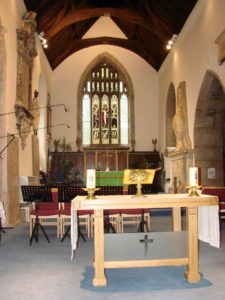
St Botolph’s, Shepshed. Rev. Peter Ollerenshaw is buried under the altar. Photo by Chet Wilcox.
Now for more Puritan associations: At St Botolph’s church at Shepshed Rev. Peter Ollerenshaw, Winifred’s father and Puritan William’s step-grandfather, appears to have been a moderate Protestant vicar. Nothing indicates that he was as radical as his contemporary Williocks in Loughborough — but Rev. Peter’s son-in-law Robert Palmer who became the vicar at Shepshed after Rev. Peter died in 1621 was definitely a more fervent reformer. We see this in the ecclesiastical court records where Rev. Robert Palmer was reporting members of his congregation to the court in the 1630s for various infractions like sleeping during the sermon, being absent from church and for keeping company with an excommunicated person. Puritanism continued with Rev. Robert’s son Thomas Palmer. Thomas became a Fifth Monarchist, a puritan fanatic, during the British commonwealth period (Interregnum). We can see that Puritan ideas were all around my Puritan William’s life — with his step-grandfather Rev. Peter Ollerenshaw, his step-uncle Rev. Robert Palmer, and his step-cousin Thomas Palmer.
One more thing about Rev. Peter Ollerenshaw. In his 1621 will he left money to tanner William’s children who were not Rev. Peter’s grandchildren. I believe my Puritan William was one of them. Rev. Peter appears to have had a fondness for tanner William’s children with his first wife since he left them a token. It’s probable that my Puritan William visited Shepshed and heard his step-grandfather Rev. Peter Ollerenshaw preach. (Rev. Peter’s will stipulated that he be buried under the altar of the church. When the church underwent renovations a few years back, coffins were found under the floor of the altar. Presumably one of them was Rev. Peter’s.)
So that’s Shepshed in a nutshell.
Rev. Adam Blakeman a.k.a. Blackman
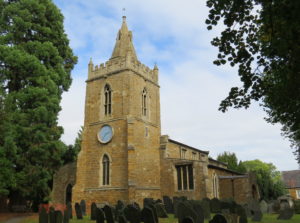
Saint Peter and Saint Paul Church, Great Bowden, where Rev. Adam Blakeman a.k.a. Blackman in Conn. preached 1624-1628.
Now on to the other Puritan Divine and one of his churches: Adam Blakeman. Blakeman (a.k.a. Blackman in New England) was Puritan William and Margaret’s minister when they started living in Stratford, Conn. in 1639. Blakeman was said to have gone to New England with a number of his flock from England, apparently including his followers from Derbyshire: my Puritan William and Margaret Wilcockson, William and Mary Beardsley and Richard Harvie who together went to New England on the Planter in 1635. Blakeman was an ordained minister and lectured in Leicestershire and Derbyshire. In Leicestershire we find him as curate at Saint Peter and Saint Paul church in Great Bowden, our second stop of the Puritan Divine day.
It’s unknown where Blakeman was after he graduated as an ordained minister from Christ College, Oxford in 1618 and before he signed the baptism registers as curate at Great Bowden in 1624. The year of his appointment to the church at Great Bowden, he apparently was at Titchmarsh, Northamptonshire, when an Adam Blakeman married Jane Monkton in January 1624. Rev. Adam’s wife in Stratford, Conn. was Jane. Blakeman is an unusual name in England during this period, so it is reasonably safe to conclude that this Adam Blakeman and Jane Monkton in 1624 were Rev. Adam Blackman and his wife Jane in Conn. in 1639. Celia Renshaw, one of the Derbyshire researchers, speculates that Blakeman may have been a private teacher or private lecturer in a wealthy household until he could find a position as minister of a church somewhere. The Pickering family (wealthy landlords) were known to be staunch Puritans in Titchmarsh. Could Rev. Adam have been the private teacher for the non-conformist Pickerings? Possibly.
After only four years at Great Bowden (and the baptism of three sons there), Blakeman was suspended from his post at Great Bowden, as seen in the Leicester Archdeaconry Act Book from 1629 — possibly for his radical reform preaching or another infraction against the establishment Anglican church. Blakeman was followed at Great Bowden by William Leverich, another reforming Puritan Divine who eventually ended up on Long Island.
In the vicinity of Great Bowden we have yet a third Puritan Divine. Originally from Leicestershire, Thomas Hooker was a major player in the reform movement and he ended up in Hartford, Conn. (Hooker by the way is one of cousin Deborah’s ancestors.) Hooker preached at Great Bowden for one day only a year after Blakeman was suspended. Hooker was known to have held gatherings of the radical reform ministers where they discussed ideas and practiced preaching. I think Blakeman could have been among Hooker’s students. Hooker supposedly said that he would rather hear no other preacher than Adam Blakeman. Interestingly, none of Blakeman’s sermons has survived. His handwriting can be found in two wills that he wrote for two of his congregants at Great Bowden and his actual words can be found in his own will that he wrote himself in Conn. in 1666. His will is very eloquently written and not typical of the standard will of the time as he brought some of his religious views into his will. (I’m working on transcribing Blackman’s will. He used Blackman rather than Blakeman in New England.)
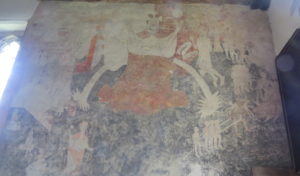 As for our tour of Saint Peter and Saint Paul church, we saw one of the gems of English history and art history there. A 14th century mural was uncovered recently after centuries of being buried under paint. The Puritans whitewashed the mural, a typical Catholic depiction of Christ, and it wasn’t discovered until the late 20th century. The Puritans whitewashed many a mural in churches and cathedrals throughout England. See Day 7 for more whitewashed murals.
As for our tour of Saint Peter and Saint Paul church, we saw one of the gems of English history and art history there. A 14th century mural was uncovered recently after centuries of being buried under paint. The Puritans whitewashed the mural, a typical Catholic depiction of Christ, and it wasn’t discovered until the late 20th century. The Puritans whitewashed many a mural in churches and cathedrals throughout England. See Day 7 for more whitewashed murals.
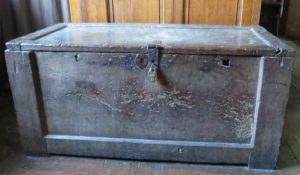
Parish chest at Saint Peter and Saint Paul church, Great Bowden.
We also saw the parish chest for Saint Peter and Saint Paul church. I had read about these parish chests in my research. They held all the important parish papers, including the parish registers that contained the baptisms, marriages and burials for the parish. The chests typically had three locks, with three different people each holding a key. (No wonder some of the events didn’t get recorded. Three people needed to be present to open the chest!) The parish chest in Great Bowden was the first one that I had seen in person.
That’s it for Great Bowden.
Today we were joined by Robb Wilcox, whom I met online only three weeks ago. He emailed to ask when my Wilcockson book would be finished. (That’s the question of the decade.) I invited him to join us since I found out that he lives west of London. He graduated from the Coast Guard Academy and is now working as a civilian for the U.S. Army in England. Like me, Robb descends from Puritan William and Margaret’s son Joseph of Killingworth, Conn. Today was peak participation day for the Wilcockson cousins on the Grand Wilcockson Tour. There were seven of us — Chet, Pat, Marilyn, Barry, Deb, Robb and I.
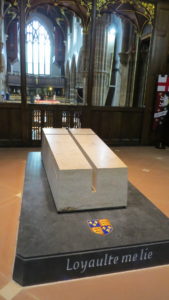
Tomb of Richard III.
A stop to see the car park king in Leicester ended our day. We went to the Leicester Cathedral to see the tomb of Richard III, whose remains as you may know were discovered a few years ago under a parking lot where a former abbey had stood. Richard was killed in battle in 1485 – the last of the Plantagenet kings – and was buried at the abbey in Leicester. The abbey was demolished, the grave was lost, and then several centuries later was found by workmen. The cathedral had not yet been built when Richard was buried. It’s a 19th century structure.
Next up tomorrow: How Puritan William Wilcockson, Margaret Harvie and Rev. Adam Blakeman intersect.
Cheers!
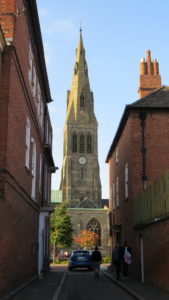
19th century Leicester Cathedral.
Categories
Tags
- Bryan Wilcockson
- Great Bowden
- John Williock
- Margaret Birdsey
- Margaret Birdseye
- Peter Ollerenshaw
- Puritan Great Migration
- Puritan non-conformists
- Puritan origins
- Rev. Adam Blackman
- Rev. Adam Blakeman
- Shepshed
- William Wilcockson
- William Wilcockson genealogy
- William Wilcoxson
- William Wilcoxson genealogy

4 thoughts on “The Grand Wilcockson Tour to Derbyshire Day 3: Shepshed, Rev. Adam Blakeman, Great Bowden and Richard III”